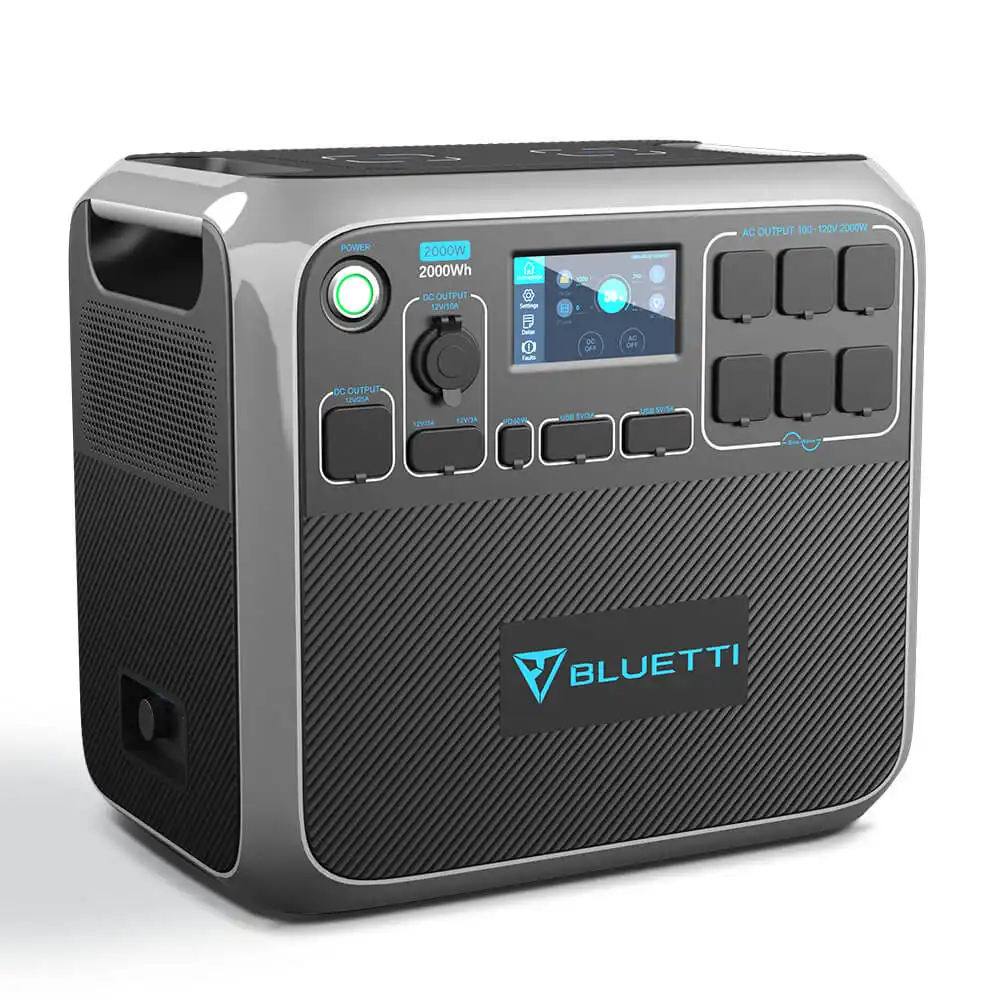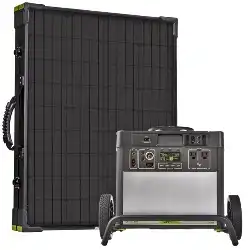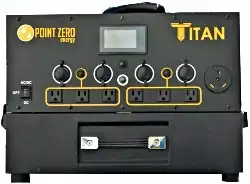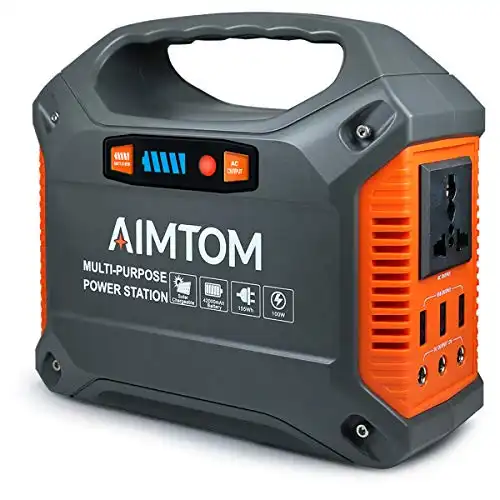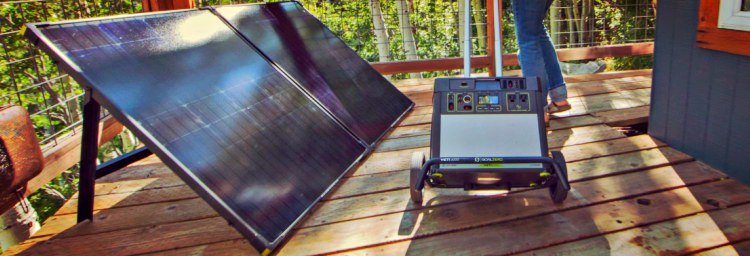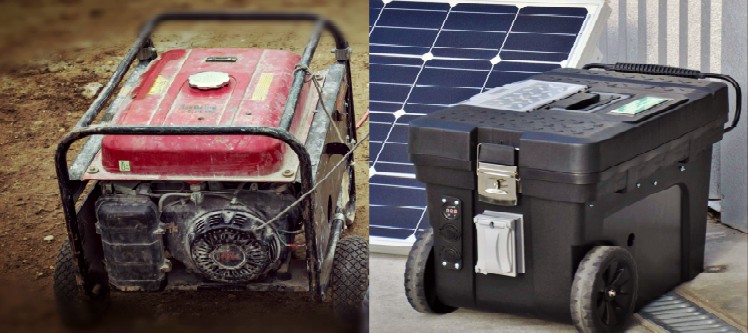3.
Titan Compact Solar Generator - Point Zero Energy
The Zero Point Titan is one of the most versatile solar generators on the market.
This solar generator is built with the most efficient, quality component making The Titan an extremely reliable solar backup for any situation.
The Titan solar generator can adapt to any situation with Zero Point's intuitive technology.
This innovative approach will give you greater portability without compromising power.
It separates the battery from the other components. That way, you can add or replace batteries quickly and easily to expand your individual power needs.
Here's a list of Titan features:
A removable and expandable lithium-ion battery allows you to add or replace batteries quickly and easily.Large battery capacity with a life span of up to 10 years.Large efficient inverter with a no-load power draw of as low as 5 watts and efficiencies up to 92%.AN oversized MPPT charge controller allows you to add up to 2000 watts of solar.A powerful AC charger will charge your battery pack in around 4 hours, with an option to add a second charger for faster charge times.MC4 to SAE connections for jump-starting with a solar panelCigarette to SAE connections for charging from a car
Check Today's Price
We earn a small commission if you make a purchase, at no additional cost to you.
↓ Titan Solar Generator
VIDEO
4.
AIMTOM 42000mAh 155Wh Power Station
The AIMTOM Power Station is the most affordable option on this list but has the most power limitations.
This unit is perfect for charging a few devices around a campsite, but it won't work as well for backup emergency power.
It's rated for 155Wh with two 110V/100-watt AC outlets, so it's more of a badass portable solar charger than a solar generator.
However, it can provide power for small home appliances (max 100 watts ), laptops, CPAP, etc.
The AIMTOM has three 5V USB outputs for phones, iPad, GPS, mp3, cameras, RC helicopters, etc.
And three 12V output ports (max 180W, with a cigarette socket ) for car devices and more.
Plus, there are also three ways you can recharge it.
You can use a supported solar panel (not included ), a car charger, or an AC wall charger.
The AIMTOM only weighs 3.48 lbs and includes an easy-carry handle.
Designed to be a portable power station, so take and use it anywhere.
Check Today's Price
We earn a small commission if you make a purchase, at no additional cost to you.
↓ Review: AIMTOM Portable Power Station – Legit Power Supply!
VIDEO Note: This solar-powered generator doesn’t come with a solar panel (sold separately ).
Before we can discuss solar generators in a meaningful way, we must first learn the basics.
It’s crucial you understand what a solar generator is and how it works.
Because a solar generator is different than a fuel-based generator.
Yes, both convert raw energy into a usable energy source.
But, instead of using fuel as raw energy, solar generators harness the power of the sun.
So, let’s talk about the components that make up a solar generator and how they work.
A solar generator consists of 2 main components:
Solar panel Portable power generator
1. Solar Panels
They do this by using sunlight to knock electrons free from atoms.
This knocking free of electrons generates a flow of electricity.
Or, more simply put, the sun’s energy excites molecules, creating a flow of electricity.
If you get that, that’s all the technical understanding you need.
The bottom line is solar panels turn sunlight into DC power.
Here’s a short video explaining how solar panels convert the sun’s rays into electricity.
↓ How Do Solar Panels Work?
VIDEO 2. Portable Power Generator
A portable solar power generator is also made up of two main components
Inverter
Battery
The inverter turns the DC power from the panel into more usable AC power.
Solar generators also include a storage battery.
That way, if any of the power captured by the panels is not being used, you don’t lose that power.
Instead, it becomes potential energy stored in the battery for later use.
The battery ensures there’s power available in an emergency.
Solar generators also include various power outlets.
These are like power outlets in your home.
They allow you to plug electrical cords, power tools, or appliances into the generator.
Click here to instantly download this Complete Checklist PDF. No purchase necessary.
Let’s move on to the more interesting and important topic of WHY .
Why should you invest in a solar-powered generator?
Why not stick to old technology you’ve always relied on – namely fossil fuels – for your backup power needs?
To answer that question, we must look at the pros and cons of solar generators vs. fuel generators.
Then we can take that information to make an informed decision.
↓ Solar Vs. Gas Generator For SHTF: Which Is Better?
VIDEO Fuel Is Expensive
We all know too well that fuel is not free.
It costs serious money to fill up our vehicles several times per month.
Fuel costs as much as it does due to a long chain of processes .
It takes money to get oil out of the ground and transport it to oil refineries.
It costs money for refineries to convert oil into fuel and distribute it to your local gas station.
And, of course, gas stations have operating costs as well.
Those costs – plus profit taken at each step – plus taxes – are what make up the price you pay at the pump.
And as we all know, those prices go up and down depending on hundreds of variables.
But when you fill up your vehicle, it’s definitely not free.
And if you’re serious about preparing for a future disaster, these costs will add up.
You’ll need to stock up if you want to run your fuel generator for more than just a few days.
That’s when the cost of choosing a fuel generator starts to add up .
And if you think, “I’ll store a small amount today and stockpile more later,” – think again. Bad idea.
That’s what everyone else does .
But fuel is one of the first materials to run out after a major disaster.
You’ll quickly discover it’s all gone, and if you do find some, it will be crazy expensive due to the laws of supply and demand.
But all these stockpiling expenses melt away with solar.
With solar, your fuel is FREE. Yes, the generator itself is not free, but the energy necessary to convert the power is.
So you don’t have the same headaches of stockpiling a massive amount of it ahead of time.
Or the ongoing fear of running out amid widespread panic.
You get an emergency power system today with zero ongoing fuel costs.
This is one of the most attractive features of owning a solar-powered generator.
Fuel Can Be Dangerous and Difficult To Store
Ok, back to that stockpiling fuel headache.
Not only will stockpiling fuel put a significant dent in your pocketbook.
It’s also challenging to store it safely and for the long haul.
Liquid fuels are highly flammable. Gasoline fumes are highly explosive . And diesel is dangerous as well.
So they are not something you want to store in bulk anywhere near your home.
Sure, storing a small gas can or two in your garage for your lawnmower is fine.
But not several large barrels of the stuff. For that, you’ll want to keep it far away from where you eat, sleep, and live.
Instead, you’ll need to store these fuels in a backyard shed or a fuel tank on a rack.
Doing this adds even more hassles and more costs.
Plus, backyard sheds are not known to be air-conditioned spaces.
So now you’re exposing combustible fuels to extreme hot and cold temperatures – not good.
And it might even be illegal for you to store much fuel .
Local laws rarely allow bulk storage of fuels in residential neighborhoods.
And even if you could, you still have the issue of fuels having a limited shelf life.
So now you’ll have to treat the fuel every so often with a fuel stabilizer .
Or you could put a fuel rotation plan in place to use old fuel and replace it with new fuel.
The bottom line is storing a lot of fuel for a long-term backup plan is one big ol’ headache!
But with a solar generator, you avoid this entire issue.
You can safely store a solar generator almost anywhere.
In your basement, garage, portable garage , bedroom, bathroom, wherever….
It’s there for when you need it, safely tucked away wherever it makes sense.
The sun is “storing” your fuel for you.
You capture that fuel as it passes by, day in and day out.
Fuel Stockpiles Eventually Run Out
Another fatal flaw with fuel generators is that fossil fuels are not renewable .
Once you use up all your fuel, you’ll have to get more.
And if you can’t get more, your backup power generator becomes a big expensive paperweight.
Your plan B just came to an end.
You’re dead in the water.
You’re up a creek without a paddle.
But the sun’s rays (from our perspective ) are an infinite power source.
Sure, the sun will stop shining someday; it technically has a finite amount of fuel.
But we’re talking billions of years from now (5 billion to be exact
So for all intents and purposes, it will never run out.
With a solar-powered generator, you’re never completely dead in the water, even if you run short of power today.
There’s always more energy to capture and convert tomorrow.
It gives a whole new meaning to the lyrics “The sun will come up tomorrow…”.
Of course, cloudy days will “rain on your parade.” But in time, those will pass as well.
Fuel Generators Are Noisy
We all know fuel generators are noisy buggers .
There’s a reason why campgrounds restrict generator usage times.
Noisy camping generators can wake an entire campsite.
But, with a solar generator, you can throw those restrictions out the window.
You can quietly generate power whenever the sun is shining without making a peep.
And this no-noise setup is not only handy for campgrounds.
It’s strategic in the event of a prolonged widespread disaster.
In a long-term power outage, the last thing you want is to notify your neighbors you have a generator.
You don’t want those who don’t have power (but would love some ) to start snooping around.
If someone knows you’ve got a generator, you can bet someone will want it.
This goes double for a situation where power is out indefinitely.
But with a solar generator, you avoid this entire racket altogether.
Fuel Generators Create Fumes
Finally, you have to deal with the fumes of traditional fuel generators.
The way fuel generators work is with lots of mini-explosions.
These small explosions create a lot of energy. But they also produce a nasty byproduct – poisonous fumes.
These fumes are harmful to breathe.
That’s why you should never let your car warm up in an enclosed garage.
These poisonous fumes can kill in dense amounts.
Usually, these fumes release into the atmosphere, where they can do less immediate harm.
The poisonous fumes become diluted in the atmosphere.
But solar creates zero fumes. It’s a zero-emission technology.
Making solar generator’s a “green” technology as well.
↓ The Prepper’s Guide to Buying A Generator: Solar Vs. Gas Vs. Standby Generator
VIDEO Click here to instantly download this Complete Checklist PDF. No purchase necessary.
Ok, so if I stopped writing here, you’d walk about with only half the story.
You’d be missing what you need to make an informed decision.
But here at Skilled Survival, we don’t do that.
We provide you with all the information you need to determine what’s best for you and your family.
That’s why we want you to understand the limitations of solar generators in their current form.
Their Output Is Somewhat Limited
Portable solar generators are not complete home grid power replacements.
If that were the case, we’d all be buying and living off solar generators, right?
Sure, some large, expensive solar array systems on a roof can offset all your energy needs.
But that takes several thousands of dollars and permits and contractors.
Instead, we’re talking about a portable backup power generator at a much lower price point.
These units do capture a fair amount of energy.
But not enough to replace the amount of energy a typical household uses daily.
Most American homes have ALL the following devices:
Refrigerator
Heating and cooling system
Several TVs
Lights everywhere
Deep freezer
Multiple computers
Smartphones
C-Pap (or other medical-related devices )
etc. etc. etc.
To date, these generators cannot capture that level of power.
And to be honest, they cannot produce as much power as a comparably priced fuel generator.
So you’re spending more money upfront on producing less sustainable power.
Bummer, I know.
So you have to weigh this against all the pros of solar-powered generators.
Now, remember, the upfront costs may be more, but you also have to think about the long-term costs.
Plus, all the other positives of a solar generator.
But no matter if you choose a fuel generator or a solar generator for backup power, you’ll have to prioritize.
For example:
You need to figure out which appliances and devices are essential and which ones are not.
Remember, you’re purchasing an emergency backup power system.
That means you’ll have power for a few emergency necessities.
And NO, binge-watching Game Of Thrones is not a necessity.
They Cost More Upfront
We touched on this already, but solar generators are an investment.
The best ones do cost a few more dollars upfront.
But don’t forget traditional generators have ongoing fuel costs you must consider.
So the more you use your solar-powered generator, the more affordable it becomes.
This is especially true when compared to a traditional fuel-based generator.
Plus, there are so many intangible costs to consider as well, such as:
the cost of running out of fuel
excessive noise
fuel storage safety concerns
harmful fumes
So you have to think long-term and see the big picture.
That’s how you decide whether the upfront investment is worth it for YOU.
Recharging Is Not Instantaneous
It takes time for a solar panel to recharge a battery.
Solar panels are not an on-and-off sort of device.
The power they capture fluctuates based on the power of the sun.
Solar panels are affected by the angle of the sun to their surface.
You’ll get a power production curve if you set your panel in a fixed position and let the sun move across the sky.
It will start out small, ramping up to the peak, hold peak power conversion for a while, and then back down to zero.
The hope is you can produce enough power over this time to run your appliances and charge your battery with solar.
Then use the stored backup battery power from sundown to sunup (overnight ).
Again, you’ll have to look at the appliances you need and how often to use them.
This is all about smart power supply management!
Of course, the more panels you have, the more power you can produce in a given time frame.
But if you charge your battery too quickly, you’ll need more batteries to store any excess energy.
But expansion is not always as simple as buying more panels or batteries.
Many Units Cannot Be Easily Expanded.
Components in ready-made solar generators are not typically designed for easy expansion.
You can’t easily upgrade the inverter when you buy one.
You can’t add a bigger battery (at least not internally ).
Nor can you increase the photovoltaic surface area or install a better inverter.
Some models do allow you to add more solar panels to increase the speed of recharging.
But eventually, you’ll hit the upper limit of the inverter in a ready-made generator.
So, for the most part, you get what you get with a ready-made solar-powered generator.
If this is a big concern of yours, you should check out some DIY solar generator options (covered later ).
Repair Can Be Difficult
Solar panels and power generators are not devices that are simple to repair.
They take unique components and serious expertise to fix.
In the case of solar panels, buying new ones is typically more cost-effective than trying to repair them.
Fortunately, newer solar panels are extremely durable and are difficult to break.
Most of the ones built nowadays can even handle extreme hail storms.
So the odds are low that you’d need to repair a portable solar generator.
But it will not be as easy as changing a tire or replacing wiper blades if you do.
So now that we’ve covered all the aspects of solar generators, it’s time to figure out if they make sense for YOU.
Of course, that depends upon your situation and your survival plans.
And since I cannot answer that question for you, I’ll provide some general thoughts instead.
To give you some general guidelines on when the purchase of a solar generator is good and when it’s not.
They are a good purchase if you consider a generator as an emergency backup and not a full replacement.
They are not a direct replacement for your home’s power consumption.
If that’s what you were hoping for, you’re mistaken.
Heck, even sizeable nonportable fuel-based home generators struggle with such a task.
And those cost tens of thousands of dollars.
A reasonably priced portable backup generator system (solar or fuel ) requires prioritization.
Prioritization Questions:
Do you want one to run a small solar refrigerator in a crisis?
Great, a solar generator may be able to do that, but that will be about all it can do.
How about a CPAP machine and charging a few smartphones ?
Great, but then running a freezer as well won’t be possible.
Do you want a way to have some lights at night and be able to use your microwave several times a day?
Perfect.
So you’ll need to think about your energy needs holistically.
You’ll have to prioritize.
For example:
One of the best solar generators can provide up to 1,500 continuous watts of power.
That’s about enough energy to charge the following devices:
cell phone
tablet
survival radio a few lights
a small appliance or a critical medical device
Obviously, this depends on the energy needs of all these devices when added together.
Or maybe, just maybe, with proper power management, you could power your freezer INDEFINITELY .
If you can do this, you’ll never have to worry about your food reserves going bad
But the point is a single solar generator cannot do it all.
You’ll have to buy more solar generators if you want to power everything.
But that comes at a significant cost increase.
One way to be strategic with your limited power is to invest in solar lighting and a solar radio .
That way, you won’t lose any of your solar generator’s power to light or sound.
Solar lanterns and radios have built-in solar panels and use LED lighting technology.
Now, a separate self-sustaining solar device may meet your emergency lighting needs (and communications ).
So the bottom line is:
You must fully understand what a solar-powered generator can and cannot do.
That’s how you make it a wise survival investment.
Click here to instantly download this Complete Checklist PDF. No purchase necessary.
Now, if you want a solar generator but you don’t like the price, you could always go the DIY route.
↓ DIY Solar Generator – Portable Lithium Battery Box Build – Part 1
VIDEO However, this is not a project for the faint of heart.
It should only be attempted by those proficient in the DIY world.
Or, put another way, this is NOT a DIY project you should cut your teeth on.
The good news is there are blueprints available on how to build a DIY solar generator system .
These blueprints are a step-by-step solution to build one for a fraction of the cost.
Sure, the blueprints cost a few dollars but think of all the money, time, and headaches you’ll save.
You should check out the Smart Solar Box DIY Solar Generator plans
↓ Building A 3.5kWh DIY Solar Generator For $650 – Start To Finish
VIDEO Some people believe all technology is dangerous.
Thinking all technological advancements are moving us all further away from a culture of self-reliance.
And instead, moving more towards a culture of helpless fools.
It’s an idea captured perfectly in one of my favorite quotes:
“What we call survival today is what our great-great-grandparents called everyday life.”
And mostly, they are right.
Here are just a few of the technologies that make us less self-reliant:
The Power Grid
The Food Distribution Network
Corporate Farming
Food Manufacturing
Interstate Delivery
Grocery Stores
Refrigeration
The Water Distribution Network
etc.
These “advancements” have made us more dependent on these advancements for our survival.
Take one of them away, and all hell breaks loose.
Because when these “societal advancements” fail, few people have a real plan B.
They have no way to survive without help and handouts.
Sure, in ordinary life, technology is beneficial.
When things are functioning smoothly, it’s awe-inspiring.
But that’s the problem; that’s precisely what makes it so dangerous.
Modern-day technological systems are as convenient as hell.
But they come at the cost of our self-reliance.
We become conditioned to helplessness.
In times of severe trouble, the real costs of these technologies will become known.
The pain, suffering, and loss will be horrific.
Now imagine a widespread, prolonged blackout .
How many people could survive a few months without power? Sadly, not many.
But not all technologies are bad.
A few technologies are being developed that do the opposite.
Ones that make us MORE self-reliant!
One of those technologies is the solar generator, so you should invest in one.
Final Thoughts
The solar-powered generators available today are impressive and worth the cost of admission.
They are the future of self-reliance that welcomes this sort of technology.
But you cannot delay. Getting a solar generator (or a traditional generator, if you prefer ) in place is critical.
You have to have a backup power plan for everyday emergencies and blackouts.
And if you’re like me, you’ll also want to have a longer-term blackout power plan in place.
And I think solar-powered generators deserve a place in that plan.
Why Trust Skilled Survival...
Go here now to review a full breakdown of:
Who We Are
Our Credentials
Our Mission
& Product Recommendations...
Here are a few highlights of our teams credentials & certifications:
Certified Member of a Mountain Search & Rescue Organization
Plant Emergency & Safety Leader for a Major Food Manufacturer
Member of the 10TH Mountain Division Hut Association
Certifications: Avalanche 1, WFR, CPR
Official Gear Tester for Numerous Outdoor Gear Companies
Countless Multiday Backpacking trips into Remote Wilderness
Bachelor's Degree In Mechanical Engineering
Bachelor's Degree In Civil Engineering
Bachelor's Degree In Biomedical Engineering
"It takes 20 years to build a reputation and five minutes to ruin it." - Warren Buffett
We're fully aware that trust is NOT something you GET but is EARNED.
And we'll continue to earn YOUR trust through our forthright and honest approach with each new Blog Post, Guide & Product we create...
Prepare, Adapt & Overcome,
Cofounder Of Skilledsurvival.com & TheResilientLife.com
Born & Raised On A Rural Farm In The Midwest
Mechanical Engineering Grad From A Major University
Engineer With A Major Food Manufacturing Company
10+ Years Researching, Writing, & Teaching Preparedness
Mission: Help Folks Stop Living A Life Fragile To The Future
Find out now using my Danger Zone County List & Special Report it’s absolutely FREE.
In minutes you’ll know EXACTLY where you stand and if you should be worried or not..
So click here to get my FREE Danger Zone County List & Report…
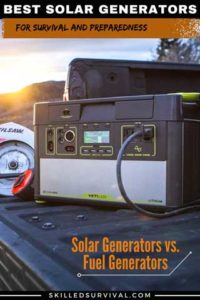

With almost twice the capacity of its competitors, the Bluetti is the Alpha.

